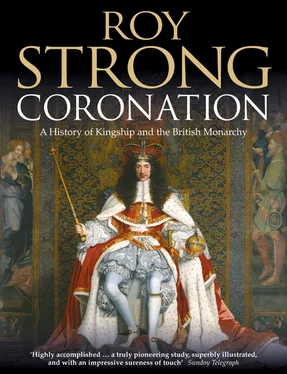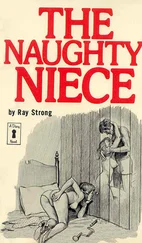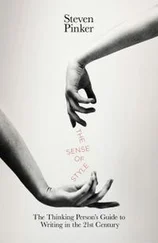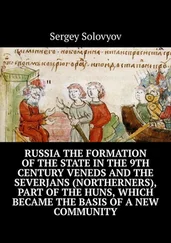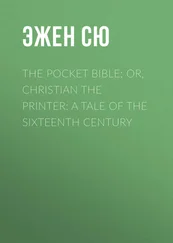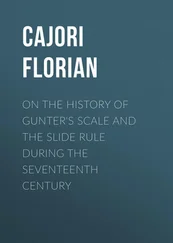So when this angel of the Lord had appeared on three successive nights with the same book of glass in his hand, and had charged him with the same commands of the Lord, for the ordaining of the same king, the holy man submitted to the word of the Lord. He sailed over to the island of Io, and there, as he had been bidden, he ordained as King Aidan, who arrived about that time. And among the words of the ordination he prophesied future things of Aidan’s sons, and grandsons, and great-grandsons. And laying his hand upon Aidan’s head he ordained and blessed him. 9
Scholarly debate concludes that such an anointing never actually took place, but, on the other hand, the text can be taken as sure evidence of a strong desire by the abbots of Iona that they should consecrate the Dalriada kings. And in order to achieve that St Columba was cast in retrospect as the reincarnation of the Old Testament prophet Samuel. The text would also indicate that by the close of the seventh century such a book with a rite for unction actually existed. As a whole the episode worked, too, from an important premise: the assertion that the Church had a key role to play in king-making.
Within the Celtic world the next appearance of royal unction is in the Collectio Canonum Hibernensis (c. 690–725), in which there is a chapter headed ‘De ordinatione regis’ with a text which implies that anointing was part of the action. The world of seventh-and eighth-century Ireland was a turbulent one with up to one hundred and fifty kings at any one time and no automatic right of succession. The introduction of unction fulfilled the twofold purpose of increasing the influence of the Church and, at the same time, stabilising disputes over succession.
Much the same motives prompted its introduction in Visigothic Spain in 672. In this case it was the further legitimisation of an elected ruler, Wamba, who received unction in the royal city of Toledo as a sign that his kingdom had been bestowed by God. But by far the most important anointing was that of Pepin, the first Carolingian king of West Francia, in 751. Pepin brought to an end the rule of the Merovingian kings, seeking sanction for his action from the pope. This was a step in terms of power politics both in the interests of the new dynasty and of the papacy during precisely the years when the Donation of Constantine was forged. Unction under the aegis of the pope not only enhanced the mystique of the new dynasty but, by implication, cast the Franks as Israel reborn, the chosen people of God. 10
As a consequence the second half of the eighth century saw an ever-escalating interplay between the papacy and the Carolingians. In the winter of 753 Pope Stephen II (752–7) crossed the Alps to reanoint Pepin and anoint his two sons. Charlemagne’s sons were anointed in Rome in 781 and 800. In the former year Pope Adrian I (772–95) made two of Charlemagne’s sons, Carloman King of Italy and Louis King of Aquitaine. But more important than any of these was what took place in Rome on Christmas Day 800 when Pope Leo III crowned Charlemagne as Holy Roman Emperor by placing a crown on his head. With that act arrived the second central symbolic action of any Coronation, the bestowal of a crown. 11
Arguments about that Coronation and what it signified continue, but no one demurs from the fact that by crowning Charlemagne the pope was introducing a rite which was associated with the Byzantine emperors. It was also one, like anointing, with a firm biblical basis. In the Second Book of Samuel an Amalekite brings David the crown and bracelet of Saul: ‘and I took the crown that was upon his head, and the bracelet that was on his arm, and have brought them hither unto my lord’ (II Samuel 1:10). Even more graphic is the account of the crowning of Joash by the chief priest: ‘And he brought forth the king’s son, and put the crown upon him, and gave him the testimony; and they made him king, and anointed him; and they clapped their hands, and said, God save the King’ (II Kings 11: 12).
Crowns had no role in barbarian installation ceremonies which could involve instead, as did the Anglo-Saxon ritual, the placing of a galea or helmet on the elected ruler’s head. In the Eastern Empire, however, the crown had been adopted as early as the Emperor Constantine in the fourth century as a symbol of his regality and vice-regency of Christ on earth. The first Byzantine emperor to be crowned by a patriarch was Leo I in 457 and the first to be crowned in a church was Phocas (602–10), but only from the second half of the seventh century did all this come to rest in the great church of Hagia Sophia. 12 In 800, therefore, the pope did what had become the norm for the patriarch, crown an emperor, only this time one of the West. The people present all acclaimed Charlemagne as ‘Augustus, crowned by God, Emperor of the Romans’. Thereafter crowns, in the case of the Holy Roman Emperors as often as not donated by the popes themselves, ousted helmets as Kings in the West opted for the style a Deo coronatus. In 816 yet another pope crossed the Alps, this time to crown Charlemagne’s son, Louis the Pious, emperor in a ceremony which, for the very first time, brought together unction and crowning within a single ritual.
All of this represented the redefinition in the West of kingship as an office, one whose remit was defined by the Christian Church and its clergy. It was they who composed the rituals which turned king-making into a liturgical rite in which the central act was anointing, preceded by an agreement of conditions formulated in an oath and followed by investiture with regalia and enthronement. That this development gained momentum was due to two factors. One was that primogeniture was unknown at that date. The most suitable candidate for ruler was chosen from within a royal family by a process of election by the principes. This secular side of king-making did not suddenly vanish with the advent of Coronation rites. Each Coronation was always prefaced by certain rituals which took place in secular space, generally in the palace. It usually involved election and an enthronement. We know little about such happenings because, unlike the Coronation in church, there was no tradition of compiling an ordo. The second reason why clerics came to play such a key role was that it was precisely during this period that they began to occupy a major part in the running of any state. In England, for instance, from as early as the reign of Athelstan (924–39) the king’s council had at its core a group of bishops who were in constant attendance on the king and were crucial players in both the legislative and administrative process.
It was inevitable that sooner or later these new king-making ceremonies would call for being codified in written form. Special ordines first emerge during the eighth century in West Francia, the result of two personalities, Charles the Bald (823–77), King of West Francia and subsequently Holy Roman Emperor, and Hincmar, Archbishop of Reims (845–82), his principal councillor. The latter is generally acknowledged as being responsible for the compilation of the four earliest ordines, including those for the 13-year-old Judith on her marriage to Æthelwulf, King of Wessex, in 856 and for Charles’s son Louis the Stammerer as King of Lotharingia in 869. These Frankish ordines were to be heavily drawn upon by those who compiled the ones for the Anglo-Saxon kings.
The Anglo-Saxons were made up of a mixture of tribes who came from an area of the Continent stretching from between the mouths of the rivers Rhine and Elbe. They began first to attack England from the third century on and then, by the middle of the fifth, decided to settle. By the close of the following century they had carved the country up into a series of petty kingdoms, each with its own royal family. The Anglo-Saxons were pagan, but during the seventh century were Christianised in the aftermath of Pope Gregory the Great’s mission of 597 to Kent. A golden age of Christian civilisation followed, which was only disrupted by a fresh wave of invasions in the form of the Vikings. It was those which precipitated the rise to dominance of the royal house of Wessex, first under Alfred and then under his descendants throughout the tenth century. They were the first kings of a united England and it is with Alfred’s descendants that we arrive for the first time on firmer ground that they inaugurated their reigns with the rite of unction.
Читать дальше
